Don’t Miss: Winged Weavers
Exhibition News: Flora and Fauna, Museum of Arts and Design, New York
 Rhonda’s friends from high school in Arizona visited New York from LA and Philadelphia in early August. We talked up the Museum of Arts and Design and the High Line as must-see sites and met them at the Museum and had a terrific time. We were all Otherworldly: Optical Delusions and Small Realities (through September 18, 2011), which features artists constructing small-scale hand-built depictions of artificial environments and alternative realities, either as sculpture or as subjects for photography and video. These are worlds of “magic realism” conceived and realized through intense engagement with materials, attention to detail, and concern for meaningful content.
Rhonda’s friends from high school in Arizona visited New York from LA and Philadelphia in early August. We talked up the Museum of Arts and Design and the High Line as must-see sites and met them at the Museum and had a terrific time. We were all Otherworldly: Optical Delusions and Small Realities (through September 18, 2011), which features artists constructing small-scale hand-built depictions of artificial environments and alternative realities, either as sculpture or as subjects for photography and video. These are worlds of “magic realism” conceived and realized through intense engagement with materials, attention to detail, and concern for meaningful content.
There were also some remarkable pieces in A Bit of Clay on the Skin: New Ceramic Jewelry (through September 4, 2011). Flora and Fauna, MAD about Nature (through November 6, 2011), however, was less successful. There were individual works that we liked, including Steffen Dam’s Marine Forms, Wayne Higby’s Mesa Gap and Beth Katelman’s Folly and the works pictured here (two of which were sold to collectors by browngrotta arts, and the Gyöngy Laky work that lead us to contact her about representation back in the 90s). But by mixing works featuring motifs from Nature, like fish and flowers and butterflies, with works made of branches and bark and other natural materials, the curator has created a bit of a mashup — two exhibitions with very different sensibilities installed as one. Museum of Arts and Design, 2 Columbus Circle, New York, NY 10019, 212-299-7777, http://www.madmuseum.org/see.
Eco-Art News: Chris Drury’s Carbon Sink Creates Controversy in Wyoming
An installation at the University of Wyoming Art Museum in Laramie by British land artist Chris Drury has heated up the debate over coal in that state http://uwartmuseum.blogspot.com/2011/07/land-artist-chris-drury-begins.html. Carbon Sink: What Goes Around Comes Around, is 36 feet in diameter, took three weeks to create and at its center features logs from trees killed by beetles, surrounded by lumps of coal. Drury had learned from students and faculty in the fall of 2010 about mountain pine beetles that have infested and killed more than 100 million acres of forest in Wyoming and other mountain states in the last decade. Scientists attribute
the infestation to the warming of the planet, which has reduced the frequency of the well-below-zero temperatures that would otherwise kill the insects. Human-caused greenhouse gas emissions are a major cause of rising temperatures; a primary contributor to greenhouse gases is the burning of coal. Two state legislators from coal-centric Campbell County were not impressed by Drury’s work. According to the Green blog of The New York Times, Representatives Tom Lubnau and Gregg Blikre, Republicans from Gillette, wrote to the University of Wyoming to complain about the sculpture, Lubnau telling a local newspaper, “…every now and then you have to use these opportunities to educate some of the folks at the University of Wyoming about where their paychecks come from,” which includes, of course, tax revenues from coal and other energy industries. http://green.blogs.nytimes.com/2011/07/21/coal-themed-sculpture-annoys-lawmakers “I just wanted to make that
connection between the burning of coal and the dying of trees,” says Drury. “But I also wanted to make a very beautiful object that pulls you in, as it were.” The work “has certainly generated a big debate,” he says, “which is good.” To see Drury’s photos of the work and the West, visit his blog at http://chrisdrury.blogspot.com/2011/07/carbon-stink.html. “Art is free to speak its truth,” he writes there, “and in the case of Carbon Sink all I am trying to do is to make many and multiple complex connections in as striking and beautiful way as I am able.” Watch for an interview with Chris Drury, filmed by the museum it will eventually be posted on its You Tube page at http://www.youtube.com/user/uwartmuseum.
Dispatches: All Things Considered IV and More at the Fuller Craft Museum
We traveled to Brockton, Massachusetts this weekend to see juried works by members of the National Basketry Organization at the Fuller Craft Museum http://www.fullercraft.org/exhibitions.html#Basketry.
Among the highlights in our view: Sunrise Artifact by Mary Giles; Woven Vessel by Jonathan Kline; Marked by a Sapsucker by Dorothy Gill Barnes; Tipped by Nancy Koenigsberg a Basket Book #5 by Arlene McGonagle (of course, we’re suckers for anything related to books). Most impressive, however, were works that appeared to be diptychs. First, was a pair of large works, Cave and Snag by Linda Bills, made a year apart, but seamlessly echoing each other in shape and offering an intriguing contrast in volume.
Second was a single piece, Wait, Weight by Jo Stealey, that seems to be two, interlocking basket/bowls of letters (yes, she had us at “A”). The show, which runs through December 11th, is worth seeing — with 85 pieces there is considerable variety in materials, technique and aesthetic. The exhibition would have benefited from more white space, however. The works are placed so close to one another it requires a second walkthrough to really focus on individual pieces.
If you can get there before Loom and Lathe: The Art of Kay Sekimachi and Bob Stocksdale closes on September 11, 2011, do. There are interesting works by Kay Sekimachi in this show that did not appear in previous exhibitions of these artists’ work. Although this exhibition also features a large number of pieces in a limited space, as a result of Stocksdale’s and Sekimachi’s minimalist aesthetic and muted color palette, the installation is more successful.
We missed Fold It: Deena Schnitman, an installation of cookbooks which is on view in the café because we didn’t know it was there. We didn’t miss the Flint Farm Stand, though, just down the road in Mansfield. Great fresh corn and ice cream that has people standing in line.
All Things Considered IV includes 12 artists whose work is represented by browngrotta arts. Click any image to see more examples of these artists’ work.
Fuller Craft Museum
455 Oak Street
Brockton, MA 02301
508-588-6000
http://www.fullercraft.org/home.html.
Search
Subscribe2
Recent Posts
- December 25, 2025
- December 19, 2025
- December 10, 2025
Pages
blogroll
Archives
- December 2025
- November 2025
- October 2025
- September 2025
- August 2025
- July 2025
- June 2025
- May 2025
- April 2025
- March 2025
- February 2025
- January 2025
- December 2024
- November 2024
- October 2024
- September 2024
- August 2024
- July 2024
- June 2024
- May 2024
- April 2024
- March 2024
- February 2024
- January 2024
- December 2023
- November 2023
- October 2023
- September 2023
- August 2023
- July 2023
- June 2023
- May 2023
- April 2023
- March 2023
- February 2023
- January 2023
- December 2022
- November 2022
- October 2022
- September 2022
- August 2022
- July 2022
- June 2022
- May 2022
- April 2022
- March 2022
- February 2022
- January 2022
- December 2021
- November 2021
- October 2021
- September 2021
- August 2021
- July 2021
- June 2021
- May 2021
- April 2021
- March 2021
- February 2021
- January 2021
- December 2020
- November 2020
- October 2020
- September 2020
- August 2020
- July 2020
- June 2020
- May 2020
- April 2020
- March 2020
- February 2020
- January 2020
- December 2019
- November 2019
- October 2019
- September 2019
- August 2019
- July 2019
- June 2019
- May 2019
- April 2019
- March 2019
- February 2019
- January 2019
- December 2018
- November 2018
- October 2018
- September 2018
- August 2018
- July 2018
- June 2018
- May 2018
- April 2018
- March 2018
- February 2018
- January 2018
- December 2017
- November 2017
- October 2017
- September 2017
- August 2017
- July 2017
- June 2017
- May 2017
- April 2017
- March 2017
- February 2017
- January 2017
- December 2016
- November 2016
- October 2016
- September 2016
- August 2016
- June 2016
- April 2016
- March 2016
- February 2016
- December 2015
- October 2015
- September 2015
- August 2015
- June 2015
- May 2015
- April 2015
- March 2015
- February 2015
- January 2015
- December 2014
- November 2014
- October 2014
- September 2014
- August 2014
- July 2014
- June 2014
- May 2014
- April 2014
- March 2014
- February 2014
- January 2014
- December 2013
- October 2013
- September 2013
- July 2013
- June 2013
- May 2013
- April 2013
- March 2013
- January 2013
- December 2012
- November 2012
- October 2012
- September 2012
- August 2012
- July 2012
- June 2012
- May 2012
- April 2012
- March 2012
- February 2012
- January 2012
- December 2011
- November 2011
- October 2011
- September 2011
- August 2011
- July 2011
- June 2011
- May 2011
- April 2011
- March 2011
- February 2011
- January 2011
- December 2010
- November 2010
- October 2010
- September 2010
- August 2010
- July 2010
- June 2010
- May 2010
- April 2010
- March 2010
- February 2010
- January 2010
- December 2009
- November 2009
- October 2009
- September 2009
- August 2009
Categories
- Acquisitions
- Aldrich Museum of Contemporary Art
- Allies for Art
- An Unexpected Approach
- Anniversary
- Architecture
- Art
- art + identity
- Art Assembled
- Art Materials
- art money
- Art Preview
- Art Textiles
- artist
- Artsy
- Awards
- bamboo
- Basketmakers
- Basketry
- Behind the Scenes
- Blue/Green
- Book Recommendations
- Books
- Catalogs
- Ceramics
- Charity
- Classes
- Collage
- Collectors
- Commentary
- Commission
- Commissions
- Danish Tapestry
- DIY
- Eco-Art
- Exhibitions
- Fashion
- Fiber Future
- Fiber Sculpture
- Film
- Galleries
- Gifts
- Guest Post
- History
- In the News
- Installations
- Japandi
- Japanese Art
- Japanese Ceramics
- Lectures
- Mixed Media
- Museums
- New This Week
- New York
- Obituary
- Obiturary
- Outdoors
- Paper
- Philadephia Museum of Art
- Photography
- Politics
- Pop-Up Exhibition
- Press
- Process Notes
- Sculpture
- SOFA
- Sweepstakes
- Tapestry
- tate modern
- Technology
- Text Art
- Travel
- Uncategorized
- Volume 50: Chronicling Fiber Art for Three Decades
- White
- White Art
- Who Said What
- Wood
- Workshops
Tags
Adela Akers art assembled Basketry browngrotta arts Carolina Yrarrázaval Dorothy Gill Barnes Ed Rossbach Gyöngy Laky Heidrun Schimmel Helena Hernmarck Hisako Sekijima James Bassler Jane Balsgaard Jennifer Falck Linssen Jin-Sook So Jiro Yonezawa John McQueen Judy Mulford Karyl Sisson Kay Sekimachi Kiyomi Iwata Kyoko KumaI Lawrence LaBianca Lenore Tawney Lewis Knauss Lia Cook Magdalena Abakanowicz Marian Bijlenga Mariette Rousseau-Vermette Mary Giles Mary Merkel-Hess Nancy Koenigsberg Nancy Moore Bess Naoko Serino Naomi Kobayashi Norma Minkowitz Rachel Max Randy Walker Sheila Hicks Sheila hicks Stéphanie Jacques Sue Lawty Tapestry Wendy Wahl Yasuhisa KohyamaAbout browngrotta.com
blogroll
reboot
site-ings
who's showing where
Subscribe
Pages
Archives
Calendar

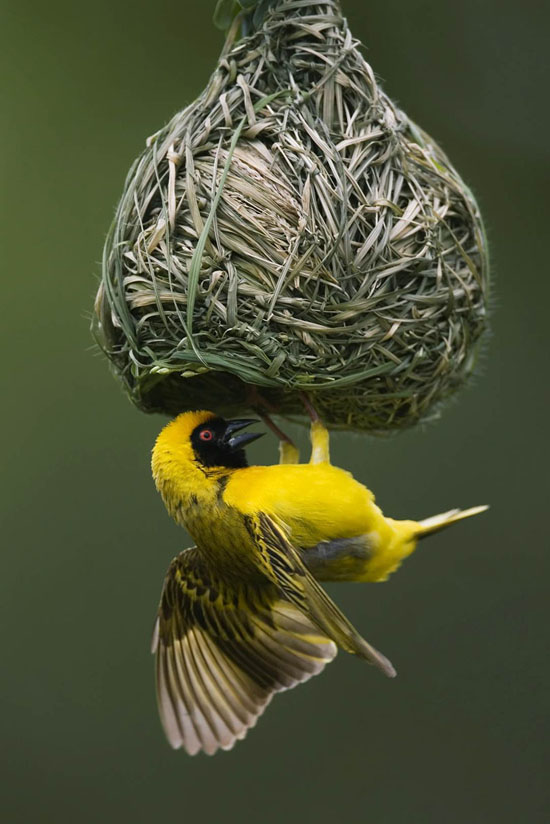
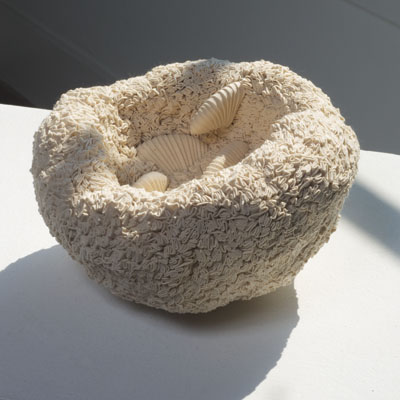
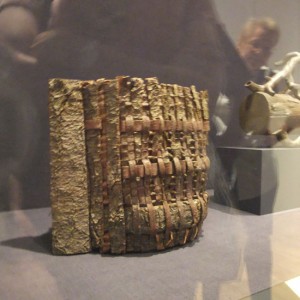
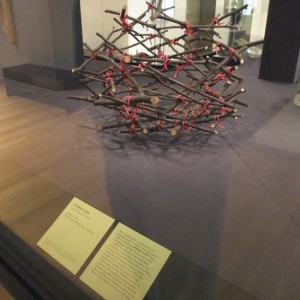
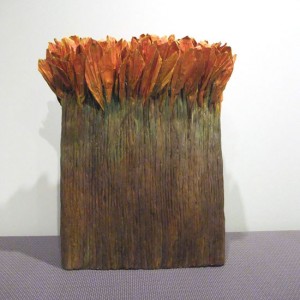
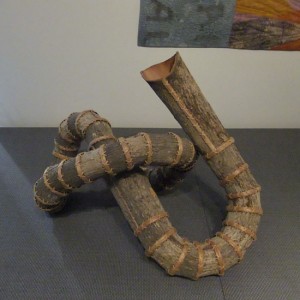

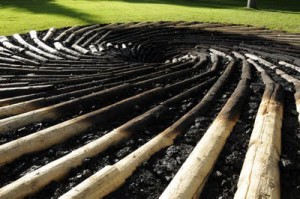
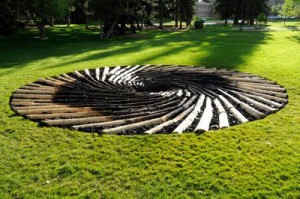

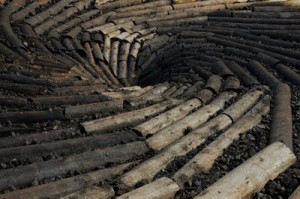


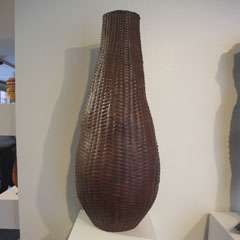
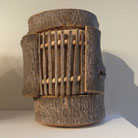
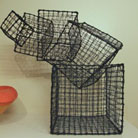
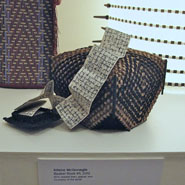
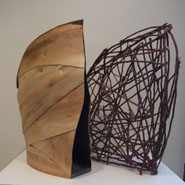
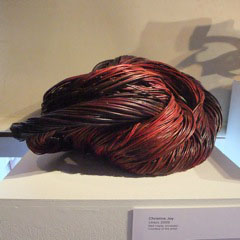
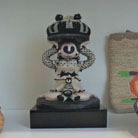

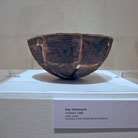
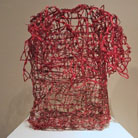


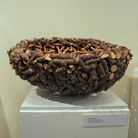
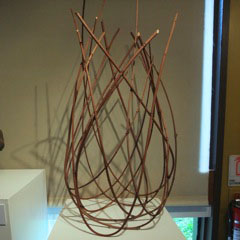
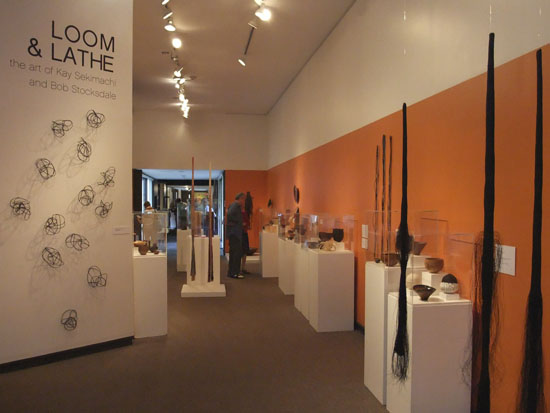

Dispatches: Art in situ on Monhegan Island, Maine
artists’ studios open to the public and to appreciate the abundant plant life and bird population. One of our favorite sites, however, was not listed in any of the literature. We were delighted when we stumbled upon an art colony of tiny structures populating Trail 11. Reminiscent of the World Beach Project https://arttextstyle.com/2010/05/14/eco-art-news-world-beach-project, in which beachgoers create sculptures of stones, visitors to Trail 11 have created small sculptures of sticks, bark, pinecones, leaves and shells. Some are more accomplished than others, but it was the sheer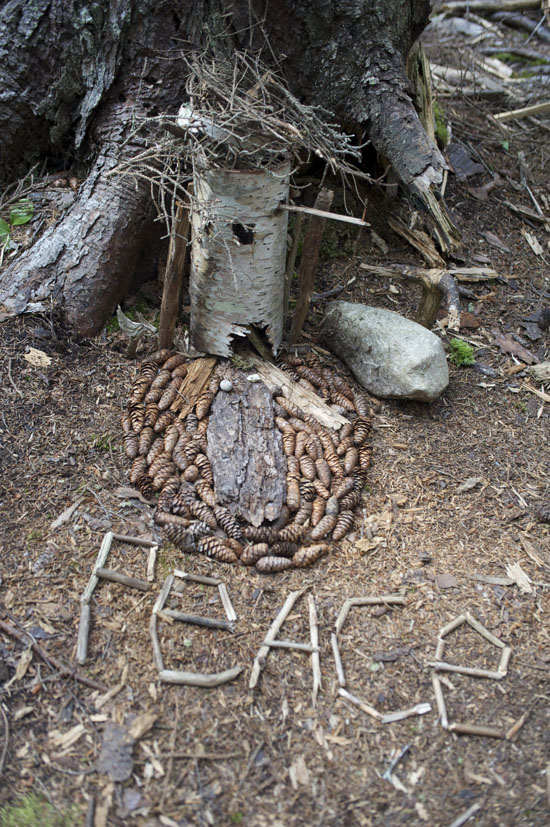
volume that impressed us. We stopped counting at 100, but until then, we had great fun looking behind tree roots, around rocks, in branches and creeks to find as many as we could. And, we couldn’t leave without making a contribution; Carter, our budding artiste, created the word “ART” out of large sticks.
Carter’s contribution to trail 11, Monhegan Island photo by Tom Grotta